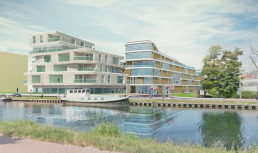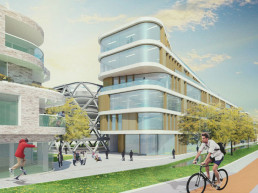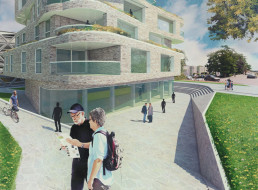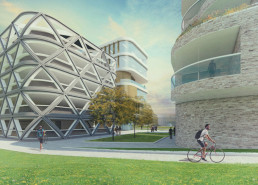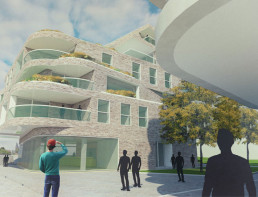“BEL M” new challenge for Ragheno Park development
Mechelen, the new centre of Belgium!
Every morning and evening, the Flemish and French-language radio stations recite the daily traffic congestions. Gridlock on the Brussels and Antwerp ring roads, delays on the N16 and the N21, congestion on the E40 at Ghent and on the E313 at Hasselt. One name you rarely hear in the daily summaries: Mechelen. A blessing for the people of Mechelen and for the city. Mechelen can promote itself as a pleasant and charming city as well as its central location and easy accessibility by road.
The City Council has been striving for some time now to further optimise Mechelen’s already excellent location and accessibility. And their efforts are paying off. Precisely because of its location between Antwerp and Brussels, Mechelen is becoming more and more popular with companies suffering from the degradation and deteriorating accessibility of these large cities. The growing number of residents demonstrates the increase in local industry. The past decade has in fact seen the number of residents in Mechelen rise by more than 7,000, bringing the population to nearly 84,000. More people are living within a 25 km radius of Mechelen’s main square than in the same radius around Antwerp and Brussels.
To exploit the city and its location’s potential even better, a large-scale redevelopment plan has been drawn up. In the plan, the area around the station will form the main hub. In the coming years, the area surrounding Mechelen’s station will undergo a complete regeneration. Not only will the city gain a new central station, the adjacent premises will be refurbished to blend in and form the new heart of the city.
The strategic extension of the large station area is one of the key aspects of Mechelen’s Municipal Structure Plan. It is the most significant urban development project taking place in Mechelen for the coming decades and will receive indisputable international acclaim. For this station area, 21st century Mechelen has decided to adopt a Sustainable Mobility concept, daring architecture and novel urban planning solutions.
These decisions involve the construction of a new railway line (Bypass) and an essential access road for people and freight transport (Tangent), the development of a multimodal railway and bus station and the reconstruction of streets and squares in the station area, resulting in traffic flow adjustments.
In this way, Mechelen Station is positioning itself as the major hub for the city’s public transport, south of the province of Antwerp and north of the province of Flemish Brabant, including for bus transport. Mechelen Station provides access to the surrounding region: both the city, the suburbs and the more remote districts. It is also where all the city and regional services stop. The new station is a few minutes’ walk from Ragheno Park.
The Tangent and the Bypass are part of the same infrastructure project, providing high-quality urban planning and architecture. Both infrastructures have been designed using an integrated approach. During the construction works, the inconvenience to the city and its residents must be minimal. The future station building – a Eurostation design created by architects Salvatore Bono and Brent Turchak – will be furnished in an attractive, user-friendly and future-oriented style.
The new station is set to become the driving force for regenerating the wider area. A mixed residential and working area will soon emerge on the southeast side of the station, bringing medieval Mechelen into the 21st century. A district should be attractive for living or just relaxing in, but above all it must welcome companies and organisations that are being confronted, elsewhere in Belgium, with space restrictions (lack of options for expansion), poor access and heavy financial burdens (too high rents). These restrictions are conspicuous by their absence in the Ragheno Park area.
Work is already in progress on part of the project area. The centralised blood transfusion service of the Flemish Red Cross was established in Ragheno Park in 2015. This marks the start of a revival of the station area that will change Mechelen’s prospects, and for the near future, definitely put the city back on the map.
To create the new project area, the city of Mechelen has opted to achieve sustainable development, on an economically feasible basis, in a socially responsible way and with minimum ecological impact on the environment.
Entirely within these essential conditions, the Beherman Group is now launching “BEL M”, its second ambitious project after “PURE M” in this area.
Bel M
The ”Bel M” project is situated in Ragheno Park’s urban area, the first area to be currently considered for development. This construction site, lying just south of the Mechelen inner ring road, is a stone’s throw from the Central Station, between Bautersemstraat, Motstraat and Hanswijkvaart. The site borders on the canal from Leuven to the river Dijle in the west.
It is in this development area that the Beherman Group established the headquarters for the centralised blood transfusion service of the Flemish Red Cross last year. The plan area will also accommodate the new office development “Pure M” designed by Jaspers & Eyers Architects.
“Bel M” is a project drawn up by DDR Architects and comprises the creation of a contemporary, multifunctional building complex including offices, a parking garage and apartments.
The entire complex, with its soft lines and pleasing colour-scheme not only meets the requirement for sustainable and flexible office units, but also provides a solution for the pressing problem in this part of the city, namely the increasing lack of parking spaces. Moreover “Bel M” also satisfies many people’s desire to be able to live on the waterfront, alongside the canal
Currently about half of the Flemish people work in office buildings. The possibilities and requirements for a modern office have changed at a rapid rate on account of social, technological and organisational developments.
However, it is essential that people who work in offices also feel at ease, and that the working environment is comfortable and energises people, at least in their field of work. “Bel M” explicitly fulfils these requirements.
For office workers, the main thing that has undergone change in recent years is the workspace. From an enclosed meeting area to a large boardroom, from an open space for deliberations to a sizeable conference room, from hot desks to fixed individual workstations, from flexible work areas without storage space to a desk flanked by filing cabinets. Architects feel more and more obliged to consider both inside and outside spaces. Also, because social developments in mobility and accessibility require them to do so. Structural progress regarding the optimization of flexibility in production processes and technical advances creates new additional opportunities to respond to the above-mentioned developments. Consequently, work will become less and less dependent on time and place. However, it remains important that a good office location stands out by being easily accessible by (motor)bike, public transport and car.
The “Bel M” location is certainly distinctive as far as the above-mentioned aspects are concerned. This is also the case from an architectural perspective, as the building is in fact made up of flexible office sections with a parking garage on various floors, largely concealed at the back of the office building. Both are flanked on the canal side by an apartment building offering various types of apartments, combined on the ground floor with small-scale restaurants and/or areas for independent professionals, subsequently culminating yet again in the diversity required of such a large-scale development.
Architecture description in powerful terms
ENTIRE PLAN
Interaction of different architectural interpretations, as a result of various complementary functions, which together form a fascinating and rich environment. In green and blue surrounded by a ring of green (BPA uncultivated garden zone) and water (wadi and canal). Integrated ‘Motstraat’ typology at the level of the public area, thus achieving a balanced streetscape on Motstraat. Morphologically connected to the surrounding buildings with volumetric growth towards the canal and the heart of the project, namely the square in between the three different interpretations. Final phase – completion of the ‘west access via canal’ section of Ragheno Park.
OFFICES
The layout features a playful combination of rounded corners and circular recesses and projections. By incorporating the curves of the entrances and terraces here and there, the façade opens up to the surrounding area in various places, on the one hand to ensure maximum communication (social interaction) and on the other hand to underline the readability and intelligibility of the space. The boundary between inside and outside fades while the façades seem to go on forever.
The gentle curves, instead of the hard, cold corners that are typical of ordinary office blocks, add continuity to the building. They evoke a connection with the adjacent canal and the boats sailing by.
The horizontal layers look characteristic of a street scene and highlight the elongated terrain. Vertical secondary elements between the layers rescale the building to human dimensions.
White is fresh and thanks to its neutrality, it soaks up the ambient colours, affording the building a lively and powerful appearance, combined with the bronze anodized aluminium which emphasises the individual identity of the office section.
The offices are ideally south-west-east facing to allow natural light in the workspace / parking north facing. Terraces for lunch break relaxation, allow light to penetrate the units and green ‘inside’ the offices.
PARKING GARAGE
Vertically positioned alongside the same premises behind the offices and apartments, with the positive effect of being mostly concealed from the streetscape.
The parking garage is not an autonomous tower block or an underlying, inaccessible ‘pedestal’ that would contribute to both anonymity and a lack of social control.
Oversupply of parking, only 85 + 14 pp are required for the new offices – apartments, which will deal with the nuisance of illegal parking and result in a high-quality public space. This will protect pedestrians and cyclists from danger.
Tension between the structurally diagonal façade elements and the spiral flow of vertical circulation. Roof grid with green elements to conceal the cars and ‘asphalt surface’ from the overall view, so that a ‘green’ and interesting spectacle is on display from the offices, apartments and adjacent buildings.
APARTMENTS
Clear focal point – beacon that connects the canal and the offices with the parking garage. Distinct presence by using the busy levels which ‘squeeze’ loose from each other, on the one hand to display ‘flower boxes’ that provide the urban fabric with the maximum amount of green, and on the other hand to create light and shade that enliven the entire monolith.

